



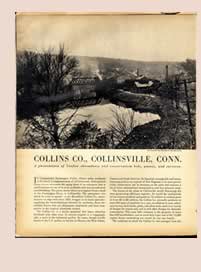


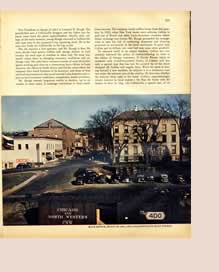



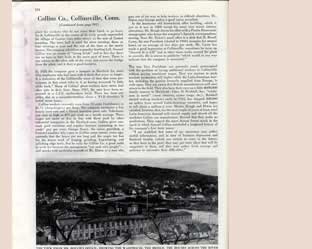
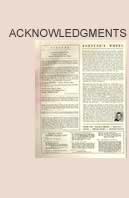
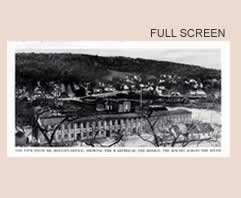
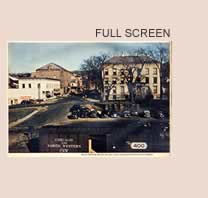

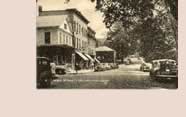
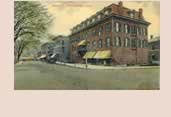
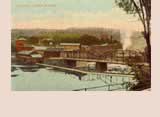
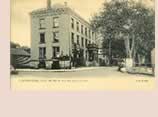
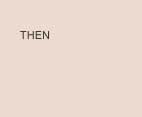
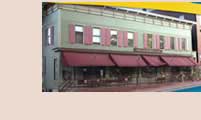
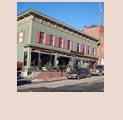




 |
 |
 |
 |
||||||||||||||||
 |
 |
 |
 |
||||||||||||||||
 |
 |
 |
 |
||||||||||||||||
 |
 |
 |
 |
||||||||||||||||
 |
 |
 |
 |
 |
|||||||||||||||
 |
 |
 |
 |
 |
 |
||||||||||||||
“COLLINS OF COLLINSVILLE, a Phenomenon of Yankee shrewdness and conservatism, bids, passes, and survives”. The January 1946 FORTUNE’S WHEEL makes particular reference to the photographs of Collinsville, “made by Walker Evans who has recently joined FORTUNE as staff photographer”. The commission fits his programme of recording the specifics of American Landscape and Economic activity as it was changing in the face of the post war expansion. This feature has not, to my knowledge, been treated with the attention it deserves in the Walker Evans literature. The images chosen provide a blend of black and white photographs of the two Vice Presidents (p.114) and a line-up of workers at their grinding wheels (p.115) . There are two wide landscape vistas in black and white (110 and p.194). Most importantly for the direction of Evans’ career, there is a double page spread with two facing colour photographs, a section of the peeling, clapboarded factory (p.112), and a highly evocative image of the Main Office on Main Street (p.113). This colour image measuring 18 x 27cms on the page I find particularly haunting and evocative. The article was art directed by Will Burtin, recruited by the magazine in 1945 from his design work in the US Army. The images chosen for the feature will have reflected Evans' own beliefs rather than the more exuberent Burtin whose deisgn style was above all devoted to FLOW. In contrast Evans has selected images of frontality, of planes in space, flanked by two black and white deep landscape vistas that largely kept to the fixity of the pages. The line-up of machetes is the shape of things to come under Burtin. The town of Collinsville is fourteen miles west of Hartford in the Farmington Valley, a settlement that the founder reluctantly allowed to bear his surname after the success of his edge tool factory in the second half of the nineteenth century. The FORTUNE article (anonymous, January 1946) stressed the particularity of the company, even its eccentricity, straggling over its site in an unplanned way through the town and along the riverbank. In the nineteenth century the staple product manufactured was the axe and the ploughshare. By the time FORTUNE called it was the Machete and similar edge tools (see page 111, examples photographed by Jacob Lofman from the Pix group) mainly for the overseas market. On p.113 Evans chooses a point of view from the top floor or perhaps the roof of the Collins Axe Company factory looking across to the four storey Main Office. The space in front of the factory is served by the Chicago and North Western Railways, brought by the company to the Town in 1850. The rolling stock seen at the foot of the photograph provides a favourite Evans motif, the lettering and logo of railway heraldry. The "400" incidentally was the line’s most famous passenger train, running from Chicago to Minneapolis/St.Paul; 400 miles in 400 minutes was the boast. The door of the wagon is open on its emptiness, but the shadow is the best indication of the angle and intensity of the sun. I have a suspicion that its placement and appearence were not entirely accidental. The glimpse of judiciously placed tyres beyond the top outline of the wagon adds a refined note in compositional terms and also could have been designed, arranged.It was not unusual for FORTUNE photographers to get their way, indulge their whims, such was the pulling power of the title. Across the entire feature we have the right to ask how Evans managed to depopulate the town? Was there a curfew? a Nuclear alert? Scarcely a person moves. No car dare take to the road. Unnerving perhaps, but also sleepy and dfreamlike. On the second corner up Main Street there is a shape that could be a solitary shopper but there again it could be a bollard. Human beings are restricted to the stiff executive portraits on p.114, and the backs of anonymous workers at their grinding stones. The paper used in this issue has that Wartime Standards feeling with a rippling surface that doesn't scan well and when matte has a certain fragility. It didn't help that my copy is stained a lurid pink in the last few pages. Look at the image on p.113. Ahead and to the left, Main Street descends down the gentle incline towards us with a cluster of shops on the corner (awnings lowered against the late autumn glare). The road then turns to our left at the crossroads to continue being Main Street. A large Coca Cola sign on the white painted wall may indicate a café/bar round this corner. The corner and frontage to this turn of Main Street with its raised sidewalk is now the one property, the La Salle Market and Deli with a stylish system of lurid awnings and shutters. Main Street in the Evans photography then continues away down the slope to our left. From the crossroads to our right runs Front Street on which the Main Office was built. To the far right Evans avoids showing another of the company’s porticoed buildings. Nevertheless the building casts its shadow on the cars of the company employees parked hurriedly along the railway frontage. Only one vehicle is a flashy two tone job. The rest of the cars are sober and dark, a line of scarabs, evenly posed in the direct afternoon's light. Perhaps it is the latecomers who, having missed the usual places, park closer and parallel to the railway track. It is a late Autumn afternoon, and the elms the founder, Samuel Collins, planted at mid-century in front of his Headquarters are leafless and stark. The low intense sun shines obliquely but strongly on the Main Office’s facades and most occupants of the building have half lowered their office shades for some relief. The quality of light, enhamced by the colour printing which is rich and intense, is that I read about in John Cheever's short stories. Cheever and Evans knew each other very well (see Cheever's Journals for the unvarnished truth). Evans’ portraits of the two Vice Presidents, Hough and Elston may have been taken in their offices in this building. Hough sits in a room with these very blinds and the caption to the landscape photograph on p.194 tells us it is “the view from Mr. Hough’s office.” The President by all accounts was a recluse, or at least avoided the publicity by thrusting his minions forward. Access to the Main Office Building from the street (then as now) is by climbing the set of rough hewn, grey stone steps with handrails from the pavement up to the portico level, to the big set of white double doors. Inside these offices, the article suggests, the talk is of the export market, accommodating the needs of the various niche requirements in hacking and splitting as reported to Head Office by their overseas sales staff. Perhaps Evans’ photograph on page 113 is taken from the roof of the Factory, to get as high a vantage point as possible to see Main Street as well as to glimpse the wooded horizon around the town. On the roof line of the Factory there is evidence of a tall chimney and ventilation ducts. There is even a brick entrance to the roof from the floors beneath. From Hough’s office, at the top of the building, Evans would have looked out past the elms over Front Street and the Railway line to the long brick frontage of the Axe Factory (called the Warehouse on page 193). Beyond, the river curls, its banks dotted with small perfectly formed houses and huts. The vantage point on page 193 is high enough to reinforce the idea that wooded hills surround the entire town. No urban sprawl here. Is it a visual distortion, or my eyes, that Evans must have been considerably higher than any front window in the Main Office Building to see so far into the landscape, to appear to be so high above the Factory? Compare the photographs on page 113 and that on page 193. Twenty year after Evans took this photograph, the Company ceased trading, its buildings converted to the needs of smaller, less productive manufacturers – antique shops, artists’ studios and the like. The railway line has been converted into a heritage trail, that ubiquitous euphemism, the Linear Park. Asked by Paul Cummings about his interest in letters and in words, WALKER EVANS: Yes. More and more that’s coming to a head
right now. Oh, yes, lettering and signs are very important to me. There
are infinite possibilities both decorative in itself and as popular art,
as folk art, and also as symbolism and meaning and surprise and double
meaning. It’s a very rich field. Given the quality of light in this and many other Evans' photographs, another section of the interview is instructive. "WALKER EVANS:
... I’m interested in the style of light. Well, of course,
light almost is photography. So I care about what it is. And there are
all kinds of light. There’s high noon, and sunlight, and there’s cross
light. I like to work in direct but in subdued cross light. Dawn and
dusk are the times to work with a camera I think. But not romantically,
just – Oral history interview with Walker Evans, 1971 Oct. 13-Dec. 23, Archives of American Art, Smithsonian Institution. A key text to the Collinsville pictures is an Evans memo to Del Paine of 1948 admiring a photograph by Jerry Cooke. (see Cooke screen ) "The picture is quiet and true. Since I am writing about photography let me point out that this picture is a better part of the story at hand than either a drawing or a painting would be. There is a profitable and well-run cracker firm in a sweaty part of the town, there is a knot of men talking on the pavement about anything but crackers, amidst the irrelevant trucks. This is where Mal-o-Mars are cooked and this is where last week's newspaper meets the gutter too. And the Strand Hotel becomes famous for flavour. My point is Fortune photographs should take a long look at a subject, get into it, and without shouting, tell a lot about it." to R.D. Paine, 23.7.48 (Walker Evans at Work).
|

GOOGLE MAPS